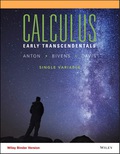
Concept explainers
Sketch the domain of f using solid lines for portions of the boundary included in the domain and dashed lines for portions not included.
Want to see the full answer?
Check out a sample textbook solution
Chapter 13 Solutions
EBK CALCULUS EARLY TRANSCENDENTALS SING
Additional Math Textbook Solutions
Algebra and Trigonometry (6th Edition)
A Problem Solving Approach To Mathematics For Elementary School Teachers (13th Edition)
Using and Understanding Mathematics: A Quantitative Reasoning Approach (6th Edition)
- please help!arrow_forward4. Let f (x) = x³ -x² + 5. a) Find the y-intercept of f. y-intercept: b) Find f' and f", and determine where each are 0 and/or do not exist (DNE). If none, write "none". f' = 0: f' DNE: f" = 0: f" DNE: c) E Do a sign analysis on f' and f". d) Find the intervals on which f is increasing and decreasing. Increasing: Decreasing: e) Find the intervals on which f is concave up and concave down. Concave up: Concave down: f) answers as (x, y) points. Find all local maxima, local minima, and inflection points of f. Be sure to write your Local max: Local min: Inflection point(s): -4 -3 -1 g) Sketch the graph of f.arrow_forwardEX: Find the F.T. of the triangular pulse: g(t) = AA (+) Sols Apply differentiation property of F-T g(t) = 2A S(t+1)_4A S(t) + 2A S(t-I) The F. I for the both sides gives. (jw)² G (w) = 2A (NE_2 +2²) (e j들 (JW)³&(W) = 4A (2 ² + 2² (e 2 G(W) = -4A whe - 8A w²t -₁) 8A ( cos 뜰 -1) = 82 (1-005) 2 sin wt 4 At sin wt 2 Wt 4 2 3/4 N 2A T ZA 0 0 8(1)-A(+) =9c How did he get the value inside the circle Hes -9C2A ہم تم at otarrow_forward
- Find all value of x for the given function defined by y=2x³ – 6x where the tangent line is horizontal. (A) 0,1 B -V3,0/3 c) -1,1 (Darrow_forward15. Let r be a positive real number. The equation for a circle of radius r whose center is the origin is x² + y² = r². dy dx (a) Use implicit differentiation to determine (b) Let (a, b) be a point on the circle with a ‡ 0 and b ‡ 0. Determine the slope of the line tangent to the circle at the point (a, b). (c) Prove that the radius of the circle to the point (a, b) is perpendicular to the line tangent to the circle at the point (a, b). Hint: Two lines (neither of which is horizontal) are perpendicular if and only if the products of their slopes is equal to −1.arrow_forward3. Consider the function f (x) = sin² x + sin x on the interval (0,27). a) Find the open interval on which the function is increasing or decreasing. b) Apply the First Derivative Test to identify all local extrema.arrow_forward
- Let f(x)be defined on the closed interval [a, b] such that the point a secant line passes through points (a, f(a)) and (b, f(b)) and the distance between a and b is y, using the definition of the derivative, find the derivative off from the given secant line.arrow_forwardPlease answer the three part question in the picturearrow_forwardDifferentiate. f(w) 1 + sec(w) 1 - sec(w)arrow_forward
- Consider the function h(x) = 1/5 x^5 − 1/3 x^3 + 2. a) Using derivatives, find the interval(s) where ℎ is increasing and the interval(s) where h is decreasing. b) Using the second derivative test, determine the location of each local maximum or minimum. c) Sketch the graph of y = h(x) using the data you gathered in parts a) and b).arrow_forwardEvaluate [f(2)dz, where f(z) = sin z, C the line segment from 0 to i f(2) = z, C_ the parabola y=x² from 0 to 1+iarrow_forwardAssume that y is a function of x. Find (d2y)/(dx2) for x2y-y2-2(sqrt x)+4=0 at point (1,2) 7/6 8/6 11/6 13/6arrow_forward
 Calculus: Early TranscendentalsCalculusISBN:9781285741550Author:James StewartPublisher:Cengage Learning
Calculus: Early TranscendentalsCalculusISBN:9781285741550Author:James StewartPublisher:Cengage Learning Thomas' Calculus (14th Edition)CalculusISBN:9780134438986Author:Joel R. Hass, Christopher E. Heil, Maurice D. WeirPublisher:PEARSON
Thomas' Calculus (14th Edition)CalculusISBN:9780134438986Author:Joel R. Hass, Christopher E. Heil, Maurice D. WeirPublisher:PEARSON Calculus: Early Transcendentals (3rd Edition)CalculusISBN:9780134763644Author:William L. Briggs, Lyle Cochran, Bernard Gillett, Eric SchulzPublisher:PEARSON
Calculus: Early Transcendentals (3rd Edition)CalculusISBN:9780134763644Author:William L. Briggs, Lyle Cochran, Bernard Gillett, Eric SchulzPublisher:PEARSON Calculus: Early TranscendentalsCalculusISBN:9781319050740Author:Jon Rogawski, Colin Adams, Robert FranzosaPublisher:W. H. Freeman
Calculus: Early TranscendentalsCalculusISBN:9781319050740Author:Jon Rogawski, Colin Adams, Robert FranzosaPublisher:W. H. Freeman
 Calculus: Early Transcendental FunctionsCalculusISBN:9781337552516Author:Ron Larson, Bruce H. EdwardsPublisher:Cengage Learning
Calculus: Early Transcendental FunctionsCalculusISBN:9781337552516Author:Ron Larson, Bruce H. EdwardsPublisher:Cengage Learning





